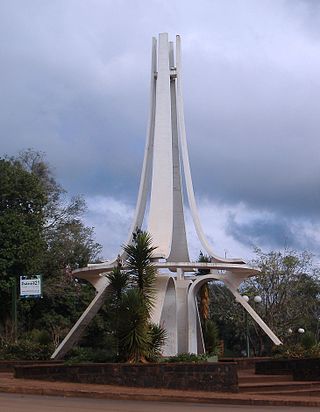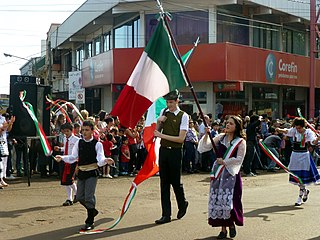
This is a demography of Argentina including population density, ethnicity, economic status and other aspects of the population.

Buenos Aires, officially the Autonomous City of Buenos Aires, is the capital and primate city of Argentina. The city is located on the western shore of the Río de la Plata, on South America's southeastern coast. "Buenos aires" is Spanish for "fair winds" or "good airs". Buenos Aires is classified as an Alpha global city, according to the Globalization and World Cities Research Network (GaWC) 2020 ranking.

Oberá, formerly Svea, is a city in the interfluvial province of Misiones, Argentina, and the head town of the Oberá Department. It is located 96 km east of the provincial capital Posadas, on National Route 14, and about 1,150 km north of Buenos Aires. It has 63,960 inhabitants according to the 2010 census [INDEC].

Immigration to Argentina began in several millennia BCE with the arrival of different populations from Asia to the Americas through Beringia, according to the most accepted theories, and were slowly populating the Americas. Upon arrival of the Spaniards, the native inhabitants of Argentine territory were approximately 300,000 people belonging to many Indigenous American civilizations, cultures, and tribes.
Irish Argentines are Argentine citizens who are fully or partially of Irish descent. Irish emigrants from the Midlands, Wexford and many counties of Ireland arrived in Argentina mainly from 1830 to 1930, with the largest wave taking place in 1850–1870. The modern Irish-Argentine community is composed of some of their descendants, and the total number is estimated at between 500,000 and 1,000,000.

Argentina has a racially and ethnically diverse population. The territory of what today is Argentina was first inhabited by numerous indigenous peoples. The first white settlers came during the period of Spanish colonization, beginning in the 16th century. The Spaniards imported African slaves, who would go on to become the first Afro-Argentines. Following independence from Spain in the 19th century and well into the 20th century, numerous migration waves took place, with Argentina being the second most popular destination for migrants in the early 20th century, after the United States. Most of these migrants came from Europe.
English Argentines are citizens of Argentina or the children of Argentine citizens brought up in Argentina, who can claim ancestry originating in England. The English settlement in Argentina, took place in the period after Argentina's independence from Spain through the 19th century. Unlike many other waves of immigration to Argentina, English immigrants were not usually leaving England because of poverty or persecution, but went to Argentina as industrialists and major landowners.

Armenian Argentines are ethnic Armenians who live in Argentina. Estimates vary, but between 70,000 and 120,000 people of Armenian ancestry live in the country, forming one of the largest groups in the Armenian diaspora worldwide. The core of the population came from Cilicia, Syria and Lebanon.

Ukrainian Argentines are Argentine citizens of Ukrainian descent or Ukraine-born people who reside in Argentina. Ukrainian Argentines are an ethnic minority in Argentina. Estimates of the Ukrainian and/or Ukrainian-descended population range from 300,000 to 470,000 people. Many Ukrainian Argentines are of Jewish descent. Currently, the main concentrations of Ukrainians in Argentina are in the Greater Buenos Aires area, with at least 100,000 people of Ukrainian descent, the province of Misiones, with at least 55,000 Ukrainians, and the province of Chaco with at least 30,000 Ukrainians. In Misiones Province Ukrainians constitute approximately 9% of the province's total population. In comparison to Ukrainians in North America, the Ukrainian community in Argentina tends to be more descended from earlier waves of immigration, is poorer, more rural, has less organizational strength, and is more focused on the Church as the center of cultural identity. Most Ukrainian Argentines do not speak the Ukrainian language and have switched to Spanish, although they continue to maintain their ethnic identity.

German Argentines are Argentines of German ancestry as well as German citizens living in Argentina. They are descendants of Germans who immigrated to Argentina from Germany and elsewhere in Europe. Some German Argentines originally settled in Brazil, then later immigrated to Argentina. Although Germany as a political entity was founded in 1871, the German language and culture have traditionally been more important than the country of origin, as the basis of the ethnic and national consciousness of Germans. Today, German Argentines make up the fifth-largest ethnic group in Argentina, with over two million citizens of Volga German descent alone.

Diplomatic relations were established in the late 19th century, between Argentina and Japan.

Italian Argentines are Argentine-born citizens who are fully or partially of Italian descent, whose ancestors were Italians who emigrated to Argentina during the Italian diaspora, or Italian-born people in Argentina.

French Argentines refers to Argentine citizens of full or partial French ancestry or persons born in France who reside in Argentina. French Argentines form one of the largest ancestry groups after Italian Argentines and Spanish Argentines. Between 1857 and 1946, 261,020 French people immigrated to Argentina. Besides immigration from continental France, Argentina also received, as early as the 1840s, immigrants with French background from neighboring countries, notably Uruguay, which expanded the French Argentine community., it was estimated that around 7 million Argentines had some degree of French ancestry, up to 17% of the total population.

Czech immigration to Argentina began during the World War I and was divided in four periods. It is estimated that around 40,000 Czechs arrived in Argentina between then and 1970. Argentina has the largest Czech community in Latin America. Czechs settled mainly in Buenos Aires, Gran La Plata, Rosario and Chaco.
Russian Argentines are people from Russia living in Argentina, and their Argentine-born descendants. The estimates of the number of Argentines of Russian descent vary between 170,000 and 350,000. They are mostly living in Buenos Aires and Greater Buenos Aires.
Swiss Argentines are Argentine citizens of Swiss ancestry or people who emigrated from Switzerland and reside in Argentina. The Swiss Argentine community is the largest group of the Swiss diaspora in South America.

Argentines are the people identified with the country of Argentina. This connection may be residential, legal, historical or cultural. For most Argentines, several of these connections exist and are collectively the source of their being Argentine. In the past the National Gentilic for Citizens of Argentina was mistakenly translated as Argentinians, a term that is no longer considered accurate.

European Argentines or White Argentines belong to several communities which trace their origins to various migrations from Europe and which have contributed to the country's cultural and demographic variety. They are the descendants of colonists from Spain during the colonial period prior to 1810, or in the majority of cases, of Spanish, Italians, French, Russians and other Europeans who arrived in the great immigration wave from the mid 19th to the mid 20th centuries, and who largely intermarried among their many nationalities during and after this wave. No recent Argentine census has included comprehensive questions on ethnicity, although numerous studies have determined that European Argentinians have been a majority in the country since 1914.
Japanese Argentines or Japanese Argentinians, are Argentine citizens of Japanese ancestry, comprising Japanese immigrants and their descendants born in Argentina. Japanese migration to Argentina began in 1908 with the arrival of immigrants from Okinawa and Kagoshima. The first Japanese entered the country via Brazil and succeeding groups of immigrants tended to reach Argentina through the neighboring nations. In the pre-war years, Japanese Argentines were concentrated in urban small businesses, especially dry cleaning and cafes in Buenos Aires, while some worked as domestic servants, factory workers and longshoremen. A minority of Japanese Argentines also engaged in horticulture, floriculture and fishery. There is an important Japanese community in the city of Belén de Escobar where they settled and specialised in floriculture.
Estonian Argentines are Argentine citizens of Estonian descent or Estonia-born people who emigrated to Argentina. Argentina is home to the fourth largest Estonian community in the Americas, behind the United States, Canada and Brazil.















